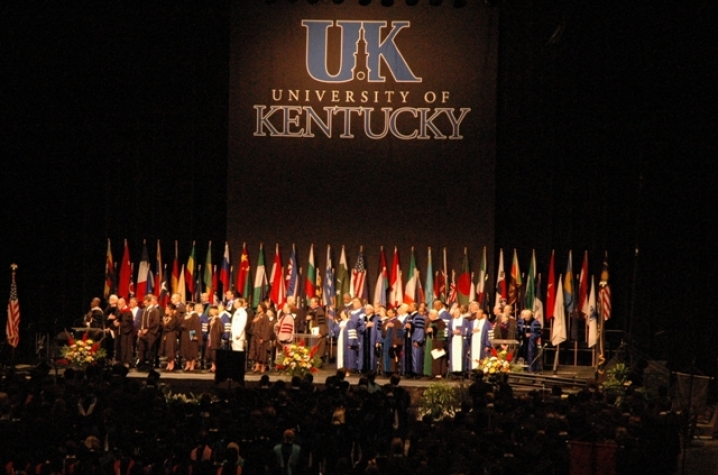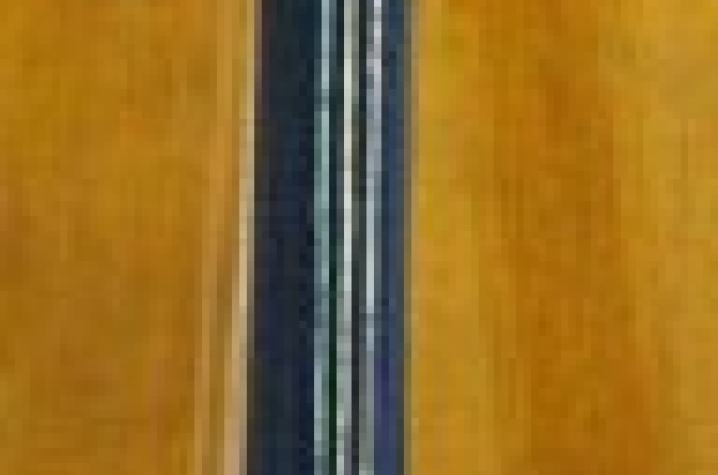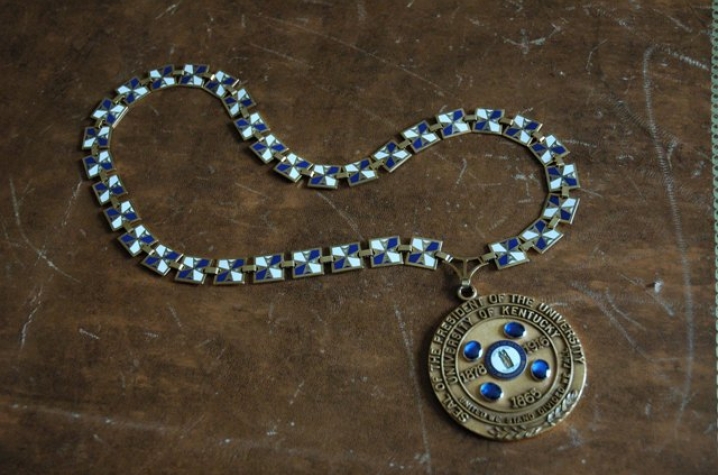Planning Pomp and Circumstance
LEXINGTON, Ky. (April 14, 2010) - It is, without question, the most-scripted and least-spontaneous event during the University of Kentucky's academic year -- just as it is the year's climactic event.
On May 8, 2010, UK will end the 2009-2010 academic year at Rupp Arena, where thousands of graduating seniors, master's degree and doctoral degree candidates, and their parents, siblings, spouses and children will gather for the University's 143rd Commencement.
What they will experience will be unrehearsed -- but every player will know exactly what to say, when to say it, where to stand when they say it and when to sit down.
All thanks to the year-long efforts of T. Lynn Williamson and John Herbst, who for nearly 40 years have handled the planning, logistics and execution of the event that celebrates UK's purpose: educating and graduating Kentucky's next generation of leaders in all professional fields.
Their efforts will be found in the final version of the Cue Book, which contains every word spoken.
"Commencement is a huge event, so there's no way we can get all of the speakers in for a rehearsal. Since there is no rehearsal, everybody has to know what they do, where they go and what they say," said Williamson, who also serves as senior associate legal counsel for the University.
Every member of the platform party will be provided a Cue Book, but the most important ones will be in the hands of UK President Lee T. Todd Jr., Commencement Orator Everett McCorvey, Williamson and Herbst.
"The final versions of the president's and orator's Cue Books may have changes being made up to two minutes before the ceremony begins," Williamson said.
But let's back up here. When do Williamson and Herbst, director of UK's Student Center and chair of the Commencement Committee begin working on the event?
"Literally, as soon as one Commencement ends, we start work on the next one immediately," Williamson said. "The first step is evaluating any issues or problems that occurred on the one we just finished."
Next, Herbst contacts the facilities managers where individual colleges held their own smaller recognition ceremonies -- events that honor their graduates and help keep the main Commencement down to a reasonable time limit.
"On the weekend of Commencement, there are 28 Commencement functions that take place. We don't have 28 facilities available, and that means we have to allocate facilities and arrange these functions on staggered schedules," Herbst said.
"Every year we have to decide who gets what," he said.
Herbst also takes stock of how his team performed.
"We have a huge amount of UK support at the Lexington Center and Rupp Arena. In addition to the staff at Lexington Center and their talented International Alliance of Theatrical and Stage Employees union crew, the UK Physical Plant, the Student Center Staff, and University Sound and Lights are heavily involved in the college events and the main Commencement, so we do a post-event evaluation of what worked, what didn't, what equipment we needed," Herbst said.
They also meet with the logistical and technical staff at Rupp Arena to identify any issues.
By December of the academic year, the facilities assignments have been determined and locked into place.
Meanwhile, Williamson is working on three publications. The first is the Commencement Web site, which has to be updated by January. Here, graduates will find answers about caps, gowns, handicapped accommodations, dining and other essentials.
"This is our primary communications link with students, and we still get about 300 questions from students. Ninety percent, I answer; 10 percent I send along to others," Williamson said.
The deadline for the second publication, the Commencement Program is around the first of April, when the names of award winners, Singletary Scholars graduates, honorary-degree awardees and the listing of 6,000 names of graduates -- with correct names and other information including their colleges and degrees -- must be submitted. Student Services Director Jacquie Hager in the Registrar's Office prepares the listing.
The third publication is the Cue Book, which is constantly subject to being updated.
All these months, Williamson and Herbst will meet frequently with the Commencement Committee, comprised of students, faculty and staff, to assist with many of the details.
On Friday, May 7, and the morning of Saturday, May 8, Herbst will scramble from one event to another, making sure microphones work, sets are in place, and myriad other details are taken care of at the 28 Commencement functions leading up to the main event.
On May 8, the day will begin early for Herbst, when he arrives at Rupp Arena at 6:30 a.m. -- making sure the arena's technical staff has prepared cameras and Internet connections, and anything else on his long list.
Around 1 p.m., students and faculty will begin arriving for the procession, which will enter the floor of Rupp Arena from four different doors. The actual lining up will start around 1:30, with Terry Malone, a special faculty member in the College of Health Sciences, coordinating the faculty marshals who provide order to each section of the procession. Each college will march in as a group, led by a student holding the college's banner.
Before the procession enters Rupp, Graduate School Dean Jeannine Blackwell conducts a hooding ceremony for graduate and doctoral students receiving their degrees. She and her staff also line up the graduate students.
Meanwhile, the platform party -- consisting of UK President Lee T. Todd Jr., Provost Kumble Subbaswamy, the UK Board of Trustees, college deans, honorary degree recipients and others -- will gather near the back of Rupp Arena.
At 2 p.m., the University of Kentucky Band will sound "Pomp and Circumstance," and Library Science Professor Lois Chan, the university marshal, will lead in the student processional. She will carry the University's ceremonial mace, used to signify the importance of the event and symbolizing UK's power to confer degrees.
After leading in the student processional, Chan will return to the back of Rupp Arena and lead in the faculty processional.
Finally, the orator will ask the audience to rise as the platform party proceeds to the stage. President Todd, wearing a ceremonial medallion presented to the University by former UK Trustee Robert McCowan, will follow Chan, with the rest of the party behind him.
From that moment on, every action -- excluding the Commencement speaker's remarks -- will follow the directions in the Cue Book.
"When Commencement happens, if no one knows T. Lynn and I exist, we've done our jobs," Herbst said.
Graduates are encouraged to connect during Commencement via Twitter and Facebook. Tweet about your experiences using the hash tag #ukgrad on www.twitter.com. Follow the University's official Twitter account @UniversityofKy for updates regarding Commencement. Invite your friends and family to attend Commencement on Facebook. Click here for the official Facebook event invitation. See Commencement through the decades here.
Commencement regalia
Every participant in the University of Kentucky Commencement will be attired in the traditional basic-black academic cap and gown. But the caps and gowns may be adorned by sleeves, tassels and hoods that bespeak the degree he or she is receiving or currently holds.
Tassels on caps have the following colors, identifying the wearer with his or her college:
Apricot - Nursing
Black - Public Health
Brown - Fine Arts
Blue Violet - Design
Citron - Social Work
Crimson - Communications and Information Studies, Journalism
Drab - Business and Economics
Gold - Arts and Sciences, Sciences
Green - Medicine
Lemon - Communications and Information Studies, Library Science
Light Blue - Education
Light Green - Health Sciences
Lilac - Dentistry
Maize - Agriculture
Maroon - Agriculture, Human Environmental Sciences
Olive Green - Pharmacy
Orange - Engineering
Purple - Law
Silver/Gray - Communications and Information Studies, Communication
White - Arts and Sciences, Arts
The sleeves of gowns identify the type of degree the graduate will receive. The gown for bachelor's degrees has pointed sleeves, and is designed to be worn closed. The master's degree gown has an oblong sleeve, open at the wrist, with the rear part of the sleeve being square cut and the front part having a cut-away arc. This gown is designed to be worn either open or closed. The doctor's degree gown has a bell-shaped sleeve that bears three velvet bars, which are usually black but can be other colors, depending on the degree.
Originally intended to shield the wearer from inclement weather, the hood now hangs loosely along the shoulders and back. The bachelor's hood is rather short with a narrow velvet edging that bears the color of the wearer's college. The lining has the blue-and-white colors of the University of Kentucky.
Considerably longer than the bachelor's, the master's hood has a wider velvet edging that exposes more of the lining. The outside velvet trim color identifies the degree the wearer is receiving.
The doctor's hood is identifiable by the even-wider velvet edging, wide panels at either side, greater length and the full exposure of the lining. The edging's colors most frequently are blue for philosophy, green for medicine and purple for law.
Honorary degree recipients do not wear their hoods until after the degrees are conferred. Part of the honorary-degree ceremony includes the candidate being vested with the hood. Honorary doctor's degree hoods are purple for law; white for arts, letters and humanities; and golden yellow for science.
The Commencement Grand Marshal, Lois Chan, leads the student and faculty processions carrying a ceremonial mace. This practice dates from the 11th Century, when the mace, previously a bludgeon used in medieval warfare, became a symbol of protection for kings and dignitaries. It eventually was adopted by universities, with its ceremonial qualities being included in the graduation processions at American universities.
President Lee T. Todd Jr. also wears a special medallion that bears the University seal. The medallion was a gift to UK's eighth president, Otis Singletary, from Robert McCowan, a former Board of Trustees member.
University of Kentucky Commencement History and Fun Facts
- UK's first commencement exercises were held in 1869 and honored one graduate.
- In 1913, UK freshmen and sophomores began a tug-of-war competition in Clifton Pond as part of the Commencement week festivities.
- 1910's commencement was the last one presided over by UK's first President James K. Patterson. At the time of his retirement, he was longest serving college president at any American university.
- Before candidates receive their degrees, the tassel is worn on the right side of the mortarboard; after conferral of the degree, the tassel is moved to the left side.
- In 1901, prior to UK's 33rd Commencement, Richard Stoll, an alumnus on the Board of Trustees, introduced the format for Commencement that is still used today.
- In the early 1900's, an alumni banquet was hosted during commencement week to welcome new graduates into alumni life.
- In 1889, graduates formed the Alumni Association.
- In 1951, Commencement was held in Memorial Coliseum for the first time. This tradition continued until 2004 when Commencement was moved to Rupp Arena.
- In 1987, the number of degrees awarded to women exceeded the number of degrees awarded to men for the first time at UK.
- UK's president hosted commencement teas on the lawn of Maxwell Place until the 1960's.
- Each university has a distinct design for the doctoral robes. President Todd's gown is red and gray because he earned his Ph.D. from the Massachusetts Institute of Technology (MIT) and that that is their institution's unique design.








